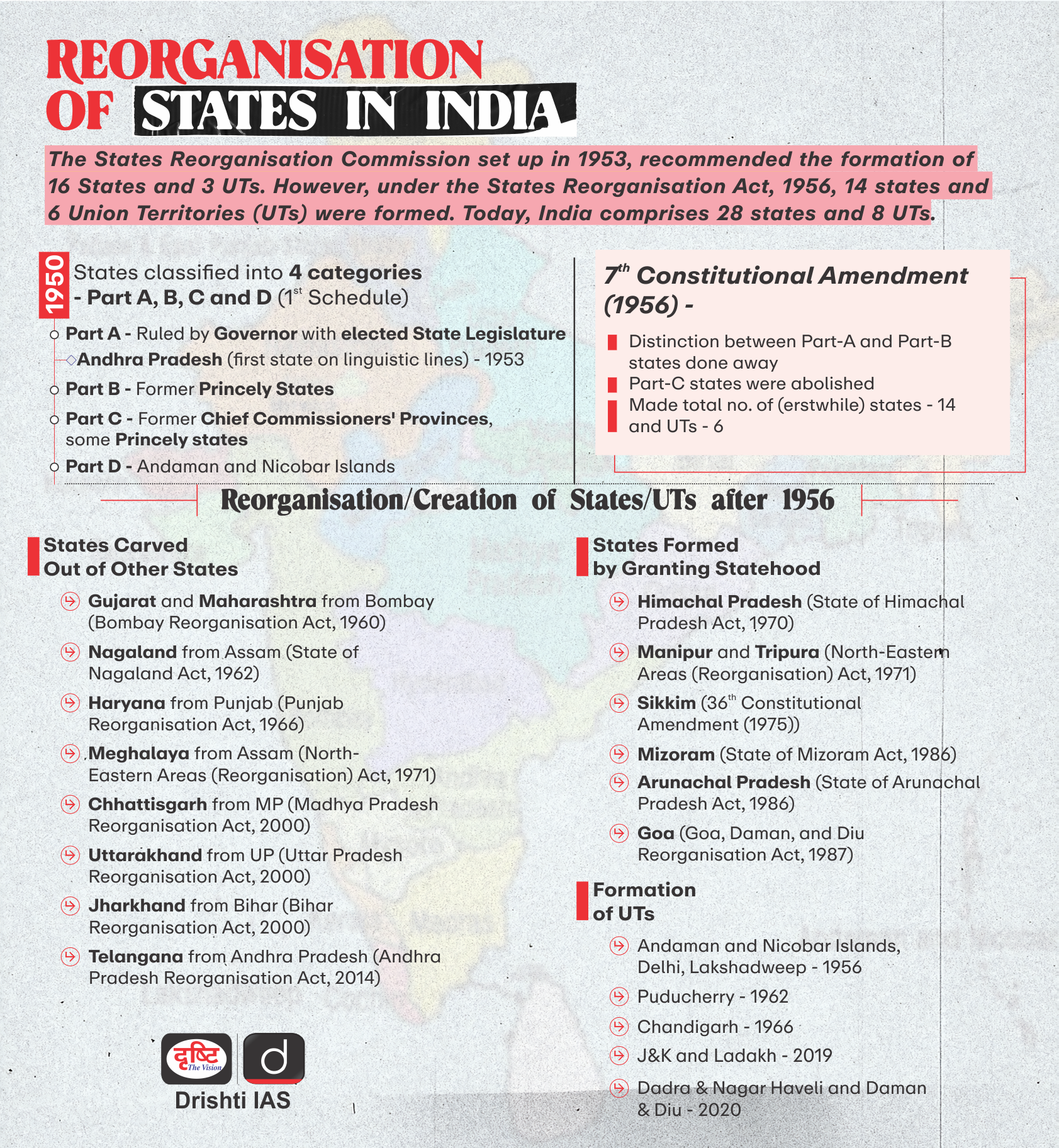Indian Polity
Linguistic Reorganisation of States
- 04 Aug 2025
- 8 min read
For Prelims: Eighth Schedule, Reorganisation of states, Potti Sreeramulu, Bhashini
For Mains: Federalism and Linguistic Reorganisation, Role of Language in Indian Polity and Nation Building
Why in News?
The Tamil Nadu Governor's criticism of India’s linguistic reorganisation of states has reignited the debate over the divisive nature of linguistic-based state creation, despite its role in maintaining India’s unity.
What is the Background of the Reorganisation of States in India?
- Initial State Classification (1950-1956): At independence, India inherited colonial-era boundaries with little coherence. The Constitution of 1950 classified states into four types: Part A (British provinces), Part B (princely states), Part C (smaller and chief commissioners' provinces), and Part D (Andaman & Nicobar).
- This temporary setup soon led to demands for a more rational reorganisation.
- Demand for Linguistic States: The demand for states based on language and cultural identity grew, especially in South India.
- Sri Potti Sreeramulu’s death in 1952 after a hunger strike led to the creation of Andhra State (with coastal districts and Rayalaseema) in 1953 as the first linguistic state, carved out of Madras.
- Government Response: To handle growing demands, the India appointed:
- Linguistic Provinces Commission (Dhar Commission) (1948): Rejected language as a basis for states.
- JVP Committee (1949): The Committee, comprising Jawaharlal Nehru, Sardar Patel, and Pattabhi Sittaramaya, warned against linguistic reorganisation due to fears of disintegration. It prioritised national unity, security.
- States Reorganisation Commission (SRC) (Fazl Ali Commission) (1953): The SRC, headed by Justice Fazl Ali with H.N. Kunzru and K.M. Panikkar as members, submitted its report in 1955.
- It accepted language as a key factor but rejected the idea of 'one language, one state', stressing the importance of unity, security, and administrative, economic, and financial considerations.
- States Reorganisation Act (1956): Based on the SRC’s recommendations, the State Reorganisation Act of 1956 was enacted, reorganising India into 14 states and 6 Union Territories, and abolishing the old Part A, B, C, and D classifications.
- Later on many Indian states were carved out due to regional identity demands and the need for better administrative efficiency, economic development, and resource control.
What are the Arguments in Favour of and Against the Linguistic Reorganisation of States?
Arguments in Favour
- Cultural Accommodation within Federalism: Linguistic reorganisation respected India's vast cultural-linguistic diversity, aligning with democratic and pluralistic values.
- Helped integrate regional aspirations into the constitutional framework, preventing alienation.
- Defused Secessionist Tendencies: Scholars argue that linguistic pluralism helped contain secessionist tendencies, unlike in Pakistan (Bengali-West Pakistan conflict) and Sri Lanka (Sinhala-Tamil divide), where forced linguistic uniformity led to violent conflict.
- Linguistic Reorganisation Provided a safety valve for ethnic expression within the Indian Union.
- Administrative Efficiency: 2nd Administrative Reforms Commission (ARC) recognised linguistic homogeneity aiding local governance and policy communication.
- linguistic homogeneity facilitated education, judiciary, and bureaucracy in the regional language.
- Political Representation and Empowerment: Enabled the rise of strong regional parties which participated actively in national politics.
- Strengthened democratic decentralisation and electoral participation.
- Strengthened Unity through Diversity: The principle of "unity in diversity" was upheld by allowing states to celebrate their language and culture without threatening national cohesion.
Arguments Against
- Rise of Regionalism and Linguistic Chauvinism: An overemphasis on linguistic identity has, in some cases, led to the exclusion of linguistic minorities within states (e.g., non marathi speakers in Maharashtra).
- This raises the risk of majoritarianism, where dominant linguistic groups suppress minority voices.
- Politicization of linguistic identities by regional political parties often inflates the demands for separate states, capitalizing on the sentiments of local communities for political gain.
- Inter-State Tensions and Border Disputes: States like Maharashtra and Karnataka continue to dispute boundaries (e.g., Belagavi issue) rooted in linguistic claims.
- Administrative Overload: Constant demands for new linguistic or identity-based states (e.g., Tulu Nadu, Vidarbha) strain governance and national consensus.
- Weakening of National Identity: Critics argue that privileging regional identity could weaken the sense of pan-Indian nationalism, especially when state interests dominate national priorities.
What Should be India's Future Strategy for Language Policy?
- Promotion of Multilingualism: No language should be imposed. The Three-Language Formula should be applied flexibly, allowing states to promote their own languages in education and governance.
- Uphold constitutional recognition of linguistic identity through the Eighth Schedule. Implement the National Education Policy, 2020 more effectively, promoting early education in mother tongues and multilingualism.
- Enforce Articles 29 and 30 to safeguard the rights of linguistic minorities in education and culture.
- Inter-State Cultural Exchanges: Strengthen programs like 'Ek Bharat Shreshtha Bharat' to foster mutual respect across linguistic regions.
- Address Linguistic Exclusion Within States: Rising sub-nationalism and exclusion of linguistic minorities need redressal through inclusive language policies at the state level.
- Multilingual Administrative Systems: Encourage multilingual signage, forms, and official communication especially in linguistically diverse states.
- Promote Bhashini to make governance and digital content available in all Indian languages.
Conclusion
India’s future lies in a multilingual, consultative, and inclusive federalism. Language should unite, not divide. Policy reforms must balance cultural autonomy with national integration, using constitutional safeguards and modern tools like Bhashini. This ensures that India's federalism adapts with dignity and fairness to its vast diversity.
UPSC Civil Services Examination, Previous Year Question (PYQ)
Prelims:
Q. Which one of the following was given classical language status recently? (2015)
(a) Odia
(b) Konkani
(c) Bhojpuri
(d) Assamese
Ans: (a)
Mains:
Q. Has the formation of linguistic states strengthened the cause of Indian unity? (2016)







